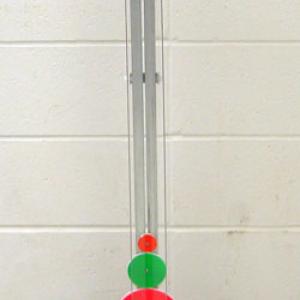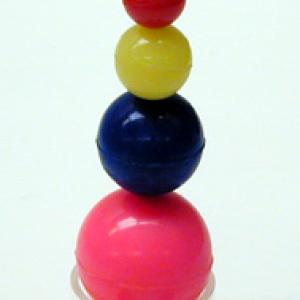College of Liberal Arts & Sciences
8B30.50 - Supernova Core Bounce
Lift the desired number of circular plates to the height you want and let them drop. The small plate should jump to a height that is based on that combination. You should almost reach the ceiling in LR1 or LR2 if you use maximum settings.
Lube the stem of the Astro-BlasterTM with some WD-40. When dropping try and make sure that when it hits the ground the stem is pointed straight up.
NOTE: Safety glasses should be worn to protect the eyes of the dropper.
- Alan W. Hirshfeld, "Bigger Bounces", TPT, Vol. 33, # 9, Dec. 1995, p. 548.
- Richard V. Mancuso and Kevin R. Long, "The Astro-Blaster", TPT, Vol. 33, # 6, p. 358, Sept. 1995.
- Walter Roy Mellen, "Aligner for Elastic Collisions of Dropped Balls", TPT, Vol. 33, # 1, p. 56-57, Jan. 1995.
- Neil M. Shea, "Nonideal Multiball Collision", TPT, Vol. 30, # 4, Apr. 1992, p. 197.
- Jaty S. Huebner and Terry L. Smith, "Multi-Ball Collisions", TPT, Vol. 30, # 1, Jan. 1992, p. 46.
- Robert A. Edger, "Supernova Core Bounce: A Demonstration", TPT, Vol. 28, # 8, Nov. 1990, p. 558.
- Kip S. Thorne, "The Death of a Star", TPT, Vol. 9, # 6, Sept. 1971, p. 326.
- John A. Wheeler, "Our Universe: The Known and the Unknown", TPT, Vol. 7, # 1, Jan. 1969, p. 24.
- Class of William G. Harter. "Velocity Amplification in Collision Experiments Involving Superballs", AJP, 39, p. 656, 1971.
- Mellon, W. R. "Superball Rebound Projectiles", AJP, 36, p. 845, 1968.
- Paul Gorenstein and Wallace Tucker, "Supernova Remnants", Scientific American, Vol. 224, # 7 to 12, 1971, p. 74.01
- Johanna Miller, "Overluminous Supernovae Push the Chandrasekhar Limit", Physics Today, May 2010, p. 11.
- "Physics Update - Shocking Start for the Solar System", Physics Today, December 2008, p. 26.
- Bertram Schwarzschild, "Most Luminous Supernova Ever Seen May be Manifesting a New Eruption Mechanism", Physics Today, p. 17, July 2007.
- John J. Cowan, Friedrich-Karl Thielemann, "R-Process Nucleosynthesis in Supernovae", Physics Today, Oct. 2004, p. 47.
- Mark Wilson, "Engineering the energy levels in quantum dots leads to optical gain", Physics Today, July 2007, p. 19-22.
- Johanna Miller, "Radar reveals Mercury's molten core", Physics Today, July 2007, p. 22-24.
- Barbara Goss Levi, "Quantum oscillations finally seen in high-temperature superconductors", Physics Today, July 2007, p. 26-28.
- Ed Sobey, Woody Sobey, "Astroblaster", The Way Toys Work, p. 8.
- Margaret D. Campbell, "Superball Collisions".
- John G. Cramer, "Supernova Duds and Toothpaste", Analog Science Fiction/Science Fact Magazine.
- Isaac Asimov, "New Stars", Fantasy and Science Fiction Magazine.
- Isaac Asimov, "Super Exploding Stars", Fantasy and Science Fiction Magazine.
- Isaac Asimov, "Brightening Stars", Fantasy and Science Fiction Magazine.
- Isaac Asimov, "The Dead-End Middle", Fantasy and Science Fiction Magazine.
- Isaac Asimov, "Beyond the Night Sky", The Roving Mind, p. 177.
- Brian Jones and Matt Fackelman, "Superball Supernova", Don't Forget the Duct Tape, p. 141 - 144.
- Bill Franklin, "Abstract: Stacked Balls - How a Ball Can Bounce Higher Than Its Starting Point", 2005 Apparatus Competition, Salt Lake City, UT.
- "Multiple Ball Drop", Physics From the Junk Drawer, 3rd Edition, The Science House, North Carolina State University, p. 26.
Disclaimer: These demonstrations are provided only for illustrative use by persons affiliated with The University of Iowa and only under the direction of a trained instructor or physicist. The University of Iowa is not responsible for demonstrations performed by those using their own equipment or who choose to use this reference material for their own purpose. The demonstrations included here are within the public domain and can be found in materials contained in libraries, bookstores, and through electronic sources. Performing all or any portion of any of these demonstrations, with or without revisions not depicted here entails inherent risks. These risks include, without limitation, bodily injury (and possibly death), including risks to health that may be temporary or permanent and that may exacerbate a pre-existing medical condition; and property loss or damage. Anyone performing any part of these demonstrations, even with revisions, knowingly and voluntarily assumes all risks associated with them.

